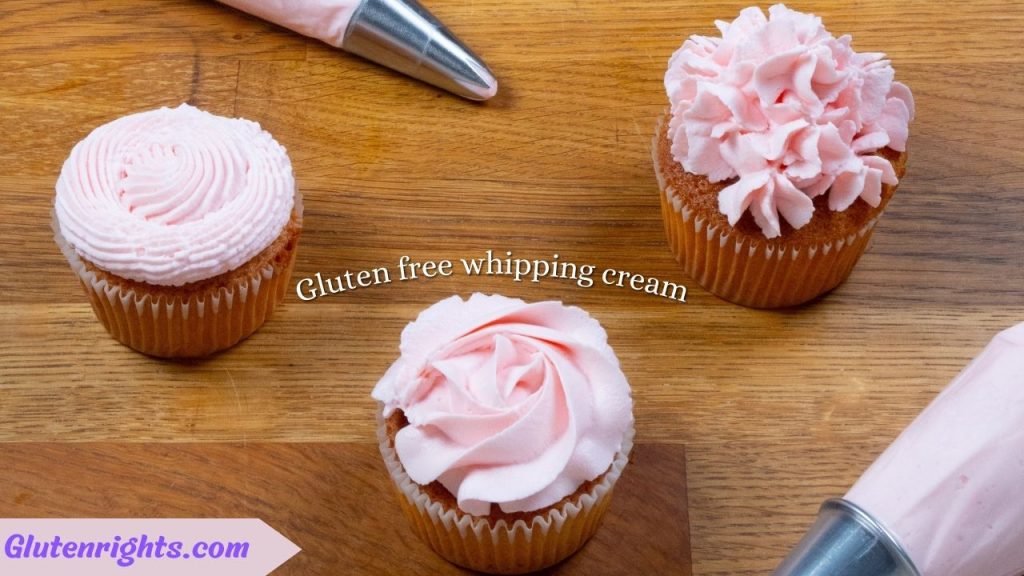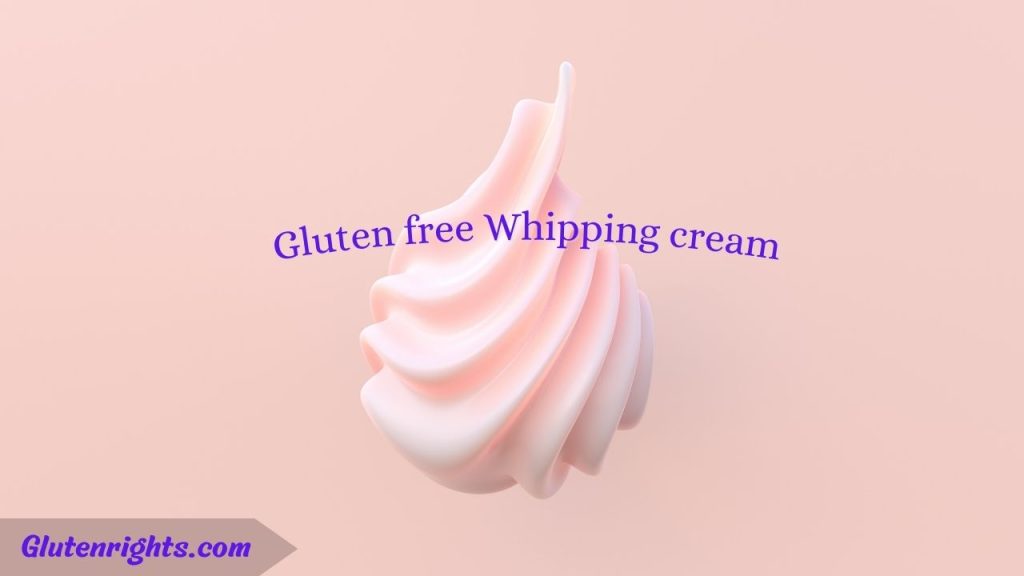It is a kind of whipped cream free of the protein gluten, which is present in several grains. For people with celiac disease or gluten intolerance who must avoid gluten in their diet, gluten free whipping cream is an option.It is made from cream that has been sourced from cows not fed a diet containing gluten containing grains, and it is processed in facilities that do not handle gluten containing ingredients.
Top Gluten Free Whipping Cream Brands
When it comes to whipping cream, those who are gluten-intolerant or have celiac disease must be careful when selecting a brand. The good news is that several well-known brands now provide whipped cream versions without gluten.
One of the top gluten free whipping cream brands is Truwhip. Truwhip is made with natural ingredients, including coconut oil, and is free from gluten, dairy, and soy. It has a creamy, whipped texture and a light, sweet flavor that is perfect for topping off cakes, pies, and other desserts.
Another popular gluten free whipping cream brand is So Delicious. This brand offers a variety of dairy-free whipped cream options, including a coconut milk-based whipped cream.The product is free of gluten, soy, and other allergies and is prepared with organic coconut milk. The whipped cream from So Delicious is the ideal finishing touch for your favourite sweets because of its rich, creamy texture and mouthwatering coconut flavour.
Finally, Reddi-wip is another popular brand that offers a gluten-free whipped cream option. This brand is known for its creamy texture and classic flavor, and their gluten-free product is made with almond milk and is free from gluten and dairy. Reddi-wip is a convenient option for topping off desserts or adding a touch of sweetness to your coffee or hot chocolate.
Also Check: gluten free condom

Gluten Free Whipping Cream Alternatives
There are several alternative ingredients that can be used in place of whipping cream to make a gluten-free dish. Here are a few options:
- Coconut Cream: Made from the meat of the coconut, coconut cream is naturally gluten-free. It has a rich, creamy texture and a mild coconut flavor that works well in many desserts, curries, and soups. When chilled, coconut cream can be whipped just like regular whipping cream to use as a topping for fruit, cake, or other sweets.
- Almond Milk Whipped Cream: Almond milk is another popular alternative for those who need to avoid gluten. It can be whipped into a light, fluffy cream that’s perfect for topping coffee, fruit, or even hot cocoa. To make almond milk whipped cream, simply chill a can of almond milk in the refrigerator overnight, then pour the thick cream that has separated from the liquid into a bowl and whip it until stiff peaks form.
- Cashew Cream: Cashews are naturally gluten-free and make a delicious alternative to gluten free whipping cream. Simply soak raw cashews in water overnight, then blend them with a bit of almond milk or water until smooth. This creamy mixture can be used as a base for soups, sauces, or whipped into a light and airy topping for desserts.
- Soy Whipping Cream: Soy whipping cream is a commercial product made from soy milk and can be found in many grocery stores. It has a similar texture and taste to regular whipping cream and can be used in the same way. Just keep in mind that not all brands of soy whipping cream are gluten free, so be sure to check the label before using it.
How to Make Homemade gluten free Whipping Cream
A flexible and delicious item that can be used in a variety of dishes is homemade gluten-free whipped cream. Whether you need it for a dessert or for cooking, this whipped cream is easy to make and can be prepared in just a few minutes.
To make gluten free whipping cream, you’ll need the following ingredients: heavy cream, powdered sugar, and vanilla extract. Pour the heavy cream into a sizable mixing basin and whip it with an electric mixer until it begins to thicken. Gradually add in the powdered sugar and vanilla extract while continuing to beat the mixture until it forms soft peaks. It’s crucial to avoid beating the cream too much because it can easily turn into butter.
Granulated sugar can be used in place of powdered sugar if you don’t have any on hand, but it might take a bit longer for the sugar to dissolve in the cream. When the whipped cream is prepared, it can either be utilised right away or refrigerated for later use.
Is Whipping Cream Gluten Free by Nature
Yes, whipping cream is naturally gluten free. Whipping cream is a dairy product that is made from the fat in milk and does not contain gluten, which is a protein found in wheat, barley, and rye. Because of this, those who have celiac disease or a gluten allergy can eat it without getting sick.
It’s important to note that not all whipped cream products are gluten-free, as some may contain gluten-containing ingredients or be processed in facilities that also process gluten-containing foods. To ensure that the whipping cream you’re consuming is gluten-free, it’s best to check the label for any added ingredients that may contain gluten, or to look for products that are specifically labeled as gluten-free.
In conclusion, if you are following a gluten-free diet, you can safely enjoy whipping cream as it is a naturally gluten-free product. However, it is always best to check the label to confirm the absence of gluten-containing ingredients, or to look for products that are specifically labeled as gluten-free to ensure that you are consuming a safe and gluten-free product.
Gluten Free Whipping Cream Recipes
Here are some gluten free whipping cream recipes that you can try:
- Whipped Cream Frosting: This is a simple recipe that requires just two ingredients, heavy cream and powdered sugar. Simply whip the heavy cream with a mixer until it forms stiff peaks, then add the powdered sugar and continue to beat until it reaches the desired consistency. Use this whipped cream frosting as a topping for cakes, cupcakes, or any other dessert of your choice.
- Whipped Cream Cheese Topping: This is a delicious and creamy topping for pancakes, waffles, or fruit. To make this recipe, simply combine cream cheese, whipping cream, and a sweetener of your choice (such as sugar, honey, or maple syrup) in a bowl and beat until it forms stiff peaks.
- Whipped Cream with Berries: This dish is straightforward but tasty and ideal for summer. Simply whip the cream with a mixer until it forms stiff peaks, then add a sweetener of your choice and mix until well combined. Spoon the whipped cream over fresh berries, such as strawberries or blueberries, and enjoy!
- This delectable dessert, which features whipped cream and chocolate sauce, is sure to please. Melt dark chocolate and heavy cream in a saucepan over low heat to create the chocolate sauce. After melting, allow the sauce to cool. Then, stir the cooled chocolate sauce into the cream after whipping it with a mixer until stiff peaks form. Serve over your favorite gluten-free dessert, such as gluten-free brownies or gluten-free ice cream.
What are the Benefits of Using Gluten Free Whipping Cream
Improved Digestive Health: One of the main benefits of using gluten free whipping cream is that it can improve digestive health for those with celiac disease or gluten intolerance. Gluten is a protein found in wheat, barley, and rye, and can cause discomfort, bloating, and other symptoms in individuals with these conditions. By using gluten free whipping cream, they can enjoy their favorite recipes without any digestive issues.
Better Nutrition: Another benefit of using gluten free whipping cream is that it is often made with healthier, more nutritious ingredients. Many gluten-free products are made with alternative flours such as almond, coconut, or rice flour, which can be lower in calories and higher in fiber and nutrients compared to traditional wheat-based products.
Versatile Cooking: From sweet to savoury recipes, gluten-free whipped cream can be used. It can be used as a base for soups and stews, to prepare sauces for savoury dishes, or to make whipped cream for sweets. This gadget is a terrific addition to any kitchen because of its versatility.
No Compromise on Taste: Finally, using gluten free whipping cream does not compromise on taste. Many gluten-free products have come a long way in terms of flavor and texture, and gluten free whipping cream is no exception. With its creamy, smooth texture and delicious flavor, it is a great alternative to traditional whipping cream and can be used in a variety of recipes without sacrificing taste.
How to Substitute Gluten Free Whipping Cream in Baking
When it comes to substituting gluten free whipping cream in baking, there are several options you can use depending on the recipe and desired outcome. Here are a few options to consider:
- Coconut cream: Coconut cream can be a good substitute for whipping cream in baking recipes. Simply chill a can of full-fat coconut milk in the refrigerator overnight, then scoop out the solidified cream and use it in place of the whipping cream. Be aware that using coconut cream will give your food a faint coconut flavour.
- Cashew cream: To make cashew cream, combine soaked cashews with water and process until smooth. This creamy and versatile nut-based cream can be used in place of whipping cream in many recipes, including baked goods.
- Soy cream: A dairy-free substitute for whipping cream that can be used in some recipes is soy cream. It is created from soy milk and tastes and feels like conventional whipped cream.
- Almond cream: Almond cream is another dairy-free alternative that can be used in place of whipping cream in baking. Simply blend almonds with water until smooth to create a cream-like consistency.

Gluten Free Whipping Cream Options for Coffee
There are several options for those looking for a gluten-free alternative to traditional whipping cream for their coffee. Here are four popular options:
- Coconut Cream: Coconut cream is a rich, creamy alternative to traditional whipping cream and is naturally gluten-free. It is made by simmering full-fat coconut milk and then separating the solids from the liquids. This cream can be whipped just like regular cream and has a distinct coconut flavor that pairs well with coffee.
- Almond Cream: Almond cream is another popular alternative to traditional whipping cream. Made from almond milk, it is naturally gluten-free and has a nutty flavor that can complement coffee. Almond cream is also lighter in texture and has a lower calorie count compared to traditional cream, making it a great option for those watching their calorie intake.
- Oat Cream: Oat cream is made from a blend of oats and water and is naturally gluten-free.It is a rich, dairy-free substitute for regular whipping cream that goes great with coffee. Oat cream is a good source of fibre and has a moderate, somewhat sweet flavour. Those who cannot tolerate lactose should consider it as well.
- Soy Cream: Made from soy milk, soy cream is inherently gluten-free. Its texture is smooth and creamy, making it a fantastic substitute for regular whipping cream.Soy cream is also lower in fat and calories compared to traditional cream, making it a great option for those who are health-conscious.
How to Use Gluten Free Whipping Cream in Cooking
Here are four ways to use gluten free whipping cream in cooking:
- Toppings: Whipping cream can be used as a topping for desserts such as pies, cakes, and fruit. Simply whip the cream until it reaches a soft peak, then spoon it over the dessert.
- Sauces: Whipping cream can be used to make a variety of sauces for savory dishes, such as pasta and vegetables. Simply heat the cream in a saucepan with herbs, spices, and seasonings, then pour it over the dish.
- Soups: Whipping cream can be added to soups to add richness and depth of flavor. Simply add a dollop of cream to a bowl of soup, or stir a small amount into the soup before serving.
- Baking: Whipping cream can also be used in baking to add richness and moisture to cakes, bread, and other baked goods. Simply fold the whipped cream into the batter or dough, or use it as a filling between layers of cake. It is a great alternative to traditional dairy cream and is perfect for those who follow a gluten-free diet.
No matter what type of whipping cream you choose, it is important to make sure it is gluten-free and safe for those who have celiac disease or a gluten intolerance. Always check the label for any potential gluten ingredients, and if you’re unsure, consult with a healthcare provider.
The Differences between Gluten Free and Regular Whipping Cream
Whipping cream without gluten, a protein present in wheat, barley, and rye, is a form of cream. This type of cream is ideal for those who are gluten intolerant or have celiac disease as it does not cause an adverse reaction in their digestive system. Gluten Free Whipping Cream is often made from almond milk, coconut milk, or rice milk and is used in recipes such as gluten-free cakes, pastries, and pies.
On the other hand, Regular Whipping Cream is made from cow’s milk and contains gluten. This type of cream is widely used in various recipes, including cakes, pastries, and pies. It is also used to make whipped cream, which is a popular topping for desserts and drinks. Regular Whipping Cream has a higher fat content than Gluten Free Whipping Cream, which gives it a rich and creamy texture. This type of cream is ideal for recipes that require a strong flavor and texture, but it may not be suitable for those with gluten intolerance or celiac disease.
In conclusion, Gluten Free Whipping Cream and Regular Whipping Cream are two different products with different ingredients, textures, and uses. While Gluten Free Whipping Cream is suitable for those with gluten intolerance or celiac disease, Regular Whipping Cream is ideal for recipes that require a rich flavor and texture. It is important to choose the right type of cream depending on your dietary needs and the recipe you are using it for.
How to Store Gluten Free Whipping Cream
It’s critical to properly store gluten-free whipped cream in order to maintain its freshness and extend its shelf life. Here are three tips for storing gluten free whipping cream:
- Refrigeration: Always store whipping cream in the refrigerator, as it is a perishable product. It is best to keep it in its original container and place it in the back of the refrigerator, where it is coolest and away from any strong odors that could affect its flavor. Whipping cream should be stored at or below 40°F.
- Shelf Life: The shelf life of whipping cream depends on several factors, including the type of cream, its fat content, and how it has been stored. On average, whipping cream has a shelf life of 5 to 7 days when stored properly in the refrigerator. Always check the expiration date on the container and discard the cream if it has passed its expiration date or if it has developed an off odor or flavor.
- Freezing: Whipping cream can also be stored in the freezer, but it is important to note that it may not whip as well after being frozen. Whipping cream can be frozen for up to three months by transferring it to an airtight container. The cream should be defrosted in the refrigerator overnight before use. Stir it well before usage.
FAQs
What can I use instead of whipping cream gluten free?
There are several dairy and non-dairy alternatives that can be used instead of whipping cream that are gluten-free. Here are a few options:
- Coconut cream: This is a great dairy-free alternative that is naturally gluten-free. It has a rich and creamy texture and can be whipped just like regular cream.
- Soy cream: Another dairy-free option, soy cream is made from soy milk and can also be whipped like regular cream. Look for brands that are labeled gluten-free to ensure they are safe to use.
Is Sealtest whipping cream gluten free?
Sealtest whipping cream is a dairy product, and as such, it does not inherently contain gluten. However, it’s always possible that there could be cross-contamination with gluten during manufacturing or processing. It’s important to always read the ingredient label and look for any potential sources of gluten which may be used as thickeners or stabilizers in some cream products.
What is non dairy whipping cream made of?
Non-dairy whipping cream is typically made from a variety of plant-based ingredients, such as vegetable oils, emulsifiers, thickeners, and sweeteners. Some common ingredients used to make non-dairy whipping cream include:
Is whipped cream and whipping cream same?
Whipping cream is a liquid cream that contains a butterfat content of around 30% to 36%, and is often used for making whipped cream. It is sometimes called heavy cream or double cream, depending on the country.
What is whipping cream made of?
Whipping cream, also known as heavy cream or double cream, is made from the high-fat layer of milk that rises to the top when raw milk is left to sit for a while. To make whipping cream commercially, the cream is separated from milk using a centrifuge.
